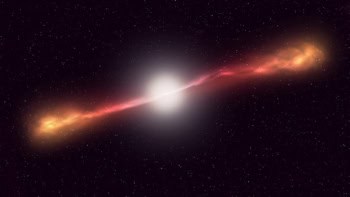
Physicists have obtained important new evidence showing that the structure of the carbon-12 nucleus – without which there would be no life here on Earth – resembles that of an equilateral triangle. The evidence was obtained by physicists in the UK, Mexico and the US by measuring a new rapidly spinning rotational state of the nucleus. The finding suggests that the “Hoyle state” of carbon-12, which plays an important role in the creation of carbon in red giant stars, has the same shape too. Recent theoretical predictions, in contrast, had suggested that the Hoyle state is more like an obtuse triangle or “bent arm”.
All the carbon in the universe is created in red giant stars by two alpha particles (helium-4 nuclei) fusing to create a short-lived beryllium-8 nucleus, which then captures a third alpha particle to form carbon-12. But exactly how this reaction occurs initially puzzled physicists, whose early understanding of carbon-12 suggested that it would proceed much too slowly to account for the known abundance of carbon in the universe. Then in 1954 the British astronomer Fred Hoyle predicted that carbon-12 had a hitherto unknown excited state – now dubbed the Hoyle state – which boosts the rate of carbon-12 production.
Three years later the Hoyle state was confirmed experimentally by physicists working at Caltech. However, the precise arrangement of the protons and neutrons in the carbon-12 nucleus remains a matter of much debate. While some physicists feel that carbon-12 is best thought of as 12 interacting nucleons, others believe that the nucleus can be modelled as three alpha particles that are bound together. The rational for the latter model is that alpha particles are extremely stable and so are likely to endure within the carbon-12 nucleus.
Molecular inspiration
If carbon-12 is indeed well described as three alpha particles, molecular physics could provide important clues about how those particles are arranged. In 2000 Roelof Bijker of the National Autonomous University of Mexico (UNAM) and Francesco Iachello at Yale University suggested that the three alpha particles could arrange themselves in an equilateral triangle in which the three alpha particles are all in the same plane. Such a structure had already been spotted five years earlier in the triatomic hydrogen molecular ion, H3+.
Now, Bijker has joined forces with Martin Freer and colleagues at the University of Birmingham and Moshe Gai at the University of Connecticut to obtain the best experimental evidence so far that carbon-12 is indeed shaped like an equilateral triangle. The experiment was carried out at Birmingham’s cyclotron by firing a beam of alpha particles at a carbon target to produce carbon-12 nuclei that are in high spin states. Indeed, the nuclei, which literally spin like tops, are rotating so fast that they tear apart by emitting alpha particles.
By measuring the energy and angular distribution of the alpha particles, the team observed a high spin state that had never been seen before. When analysed along with four lower spin states measured in previous experiments, the new data suggest very strongly that the carbon-12 nucleus resembles an equilateral triangle that has been set spinning like a three-pointed pinwheel.
Breathing nucleus
This description applies to the ground-state rotational band of carbon-12, but it also has significance for the Hoyle state. This is because the spectrum of the Hoyle-state rotational band appears to be similar to that of the ground-state band – with two of the five spin states measured already. However, the Hoyle state appears to have a larger moment of inertia than the ground state. This suggests that the Hoyle state is a “breathing mode” whereby the equilateral triangle expands. This expanded nucleus can itself be set spinning, resulting in a series of excited states similar to that of the ground-state band of carbon-12.
This evidence pointing towards an equilateral-triangle-shaped Hoyle state appears to be at odds with the recent calculations that suggested that it is more like an obtuse triangle. However, alpha-decay measurements do not give physicists the complete picture of the shape of a nucleus and the only way to be sure of the structure is to study the gamma rays that are given off when a spin state decays. While such studies are commonplace in nuclear physics, they are much harder for carbon-12 because the nucleus is much more likely to decay by emitting an alpha particle than a gamma ray.
Freer and colleagues are now, however, developing an experiment that will try to capture the gamma rays given off by the spinning carbon-12 nuclei and hope to be making measurements before the end of this year. So 60 years after the Hoyle state was predicted, we may finally know its shape.
The research is described in Physical Review Letters.



